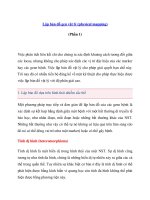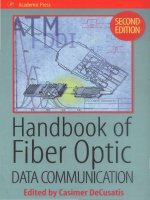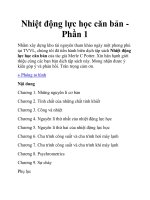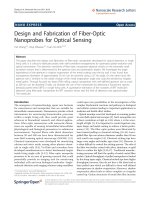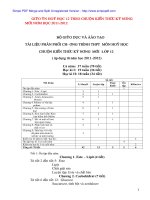Overview of Fiber Optic Sensors phần 1 pot
Bạn đang xem bản rút gọn của tài liệu. Xem và tải ngay bản đầy đủ của tài liệu tại đây (35.96 KB, 10 trang )
Overview of Fiber Optic Sensors
Over the past twenty years two major product revolutions have taken place due to the
growth of the optoelectronics and fiber optic communications industries. The
optoelectronics industry has brought about such products as compact disc players, laser
printers, bar code scanners and laser pointers. The fiber optic communication industry has
literally revolutionized the telecommunication industry by providing higher performance,
more reliable telecommunication links with ever decreasing bandwidth cost. This
revolution is bringing about the benefits of high volume production to component users
and a true information superhighway built of glass.
In parallel with these developments fiber optic sensor [1-6] technology has been a major
user of technology associated with the optoelectronic and fiber optic communication
industry. Many of the components associated with these industries were often developed
for fiber optic sensor applications. Fiber optic sensor technology in turn has often been
driven by the development and subsequent mass production of components to support
these industries. As component prices have fallen and quality improvements have been
made, the ability of fiber optic sensors to displace traditional sensors for rotation,
acceleration, electric and magnetic field measurement, temperature, pressure, acoustics,
vibration, linear and angular position, strain, humidity, viscosity, chemical measurements
and a host of other sensor applications, has been enhanced. In the early days of fiber optic
sensor technology most commercially successful fiber optic sensors were squarely targeted
at markets where existing sensor technology was marginal or in many cases nonexistent.
The inherent advantages of fiber optic sensors which include their ability to be lightweight,
of very small size, passive, low power, resistant to electromagnetic interference, high
sensitivity, wide bandwidth and environmental ruggedness were heavily used to offset their
major disadvantages of high cost and unfamiliarity to the end user.
The situation is changing. Laser diodes that cost $3000 in 1979 with lifetimes measured in
hours now sell for a few dollars in small quantities, have reliability of tens of thousands of
hours and are used widely in compact disc players, laser printers, laser pointers and bar
code readers. Single mode optical fiber that cost $20/m in 1979 now costs less than
$0.10/m with vastly improved optical and mechanical properties. Integrated optical
devices that were not available in usable form at that time are now commonly used to
support production models of fiber optic gyros. Also, they could drop dramatically in
price in the future while offering ever more sophisticated optical circuits. As these trends
continue, the opportunities for fiber optic sensor designers to produce competitive
products will increase and the technology can be expected to assume an ever more
prominent position in the sensor marketplace. In the following sections the basic types of
fiber optic sensors that are being developed will be briefly reviewed followed by a
discussion of how these sensors are and will be applied.
Basic Concepts and Intensity Based Fiber Optic Sensors
Fiber optic sensors are often loosely grouped into two basic classes referred to as extrinsic
or hybrid fiber optic sensors, and intrinsic or all fiber sensors. Figure 1 illustrates the case
of an extrinsic or hybrid fiber optic sensor.
Input Fiber
Output Fiber
Environmental Signal
Light Modulator
Figure 1. Extrinsic fiber optic sensors consist of optical fibers that lead up to and out of a "black box" that
modulates the light beam passing through it in response to an environmental effect.
In this case an optical fiber leads up to a "black box" which impresses information onto the
light beam in response to an environmental effect. The information could be impressed in
terms of intensity, phase, frequency, polarization, spectral content or other methods. An
optical fiber then carries the light with the environmentally impressed information back to
an optical and/or electronic processor. In some cases the input optical fiber also acts as
the output fiber. The intrinsic or all fiber sensor shown in Figure 2 uses an optical fiber to
carry the light beam and the environmental effect impresses information onto the light
beam while it is in the fiber. Each of these classes of fibers in turn has many subclasses
with, in some cases sub subclasses (1) that consist of large numbers of fiber sensors.
Optical Fiber
Environmental
Signal
Figure 2. Intrinsic fiber optic sensors rely on the light beam propagating through the optical fiber being
modulated by the environmental effect either directly or through environmentally induced optical path
length changes in the fiber itself.
In some respects the simplest type of fiber optic sensor is the hybrid type that is based on
intensity modulation [7-8]. Figure 3 shows a simple closure or vibration sensor that
consist of two optical fibers that are held in close proximity to each other. Light is
injected into one of the optical fibers and when it exits the light expands into a cone of
light whose angle depends on the difference between the index of refraction of the core
and cladding of the optical fiber. The amount of light captured by the second optical fiber
depends on its acceptance angle and the distance d between the optical fibers. When the
distance d is modulated, it in turn results in an intensity modulation of the light captured.
d
Figure 3. Closure and vibration fiber optic sensors based on numerical aperture can be used to support
door closure indicators and measure levels of vibration in machinery.
A variation on this type of sensor is shown in Figure 4. Here a mirror is used that is
flexibly mounted to respond to an external effect such as pressure. As the mirror position
shifts the effective separation between the optical fibers shift with a resultant intensity
modulation. These types of sensors are useful for such applications as door closures
where a reflective strip, in combination with an optical fiber acting to input and catch the
output reflected light, can be used.
Flexible
Mounted
Mirror
Figure 4. Numerical aperture fiber sensor based on a flexible mirror can be used to measure small
vibrations and displacements.
By arranging two optical fibers in line, a simple translation sensor can be configured as in
Figure 5. The output from the two detectors can be proportioned to determine the
translational position of the input fiber.
Input
Light
Collection
Fibers
Detectors
Figure 5. Fiber optic translation sensor based on numerical aperture uses the ratio of the output on the
detectors to determine the position of the input fiber.
Several companies have developed rotary and linear fiber optic position sensors to support
applications such as fly-by-light [9]. These sensors attempt to eliminate electromagnetic
interference susceptibility to improve safety, and to reduce shielding needs to reduce
weight. Figure 6 shows a rotary position sensor [10] that consists of a code plate with
variable reflectance patches placed so that each position has a unique code. A series of
optical fibers are used to determine the presence or absence of a patch.
Variable
Reflectance
Shaft
Input/Output
Fibers
Figure 6. Fiber optic rotary position sensor based on reflectance used to measure rotational position of the
shaft via the amount of light reflected from dark and light patches.
An example of a linear position sensor using wavelength division multiplexing [11] is
illustrated by Figure 7. Here a broadband light source which might be a light emitting
diode is used to couple light into the system. A single optical fiber is used to carry the
light beam up to a wavelength division multiplexing (WDM) element that splits the light
into separate fibers that are used to interrogate the encoder card and determine linear
position. The boxes on the card of Figure 7 represent highly reflective patches while the
rest of the card has low reflectance. The reflected signals are then recombined and
separated out by a second wavelength division multiplexing element so that each
interrogating fiber signal is read out by a separate detector.
Light Source
Detectors
Encoder
Card
WDMs
λ
1
λ
2
λ
3
λ
3
λ
2
λ
1
Figure 7. Linear position sensor using wavelength division multiplexing decodes position by measuring
the presence or absence of reflective patch at each fiber position as the card slides by via independent
wavelength separated detectors.
A second common method of interrogating a position sensor using a single optical fiber is
to use time division multiplexing methods [12]. In Figure 8 a light source is pulsed. The
light pulse then propagates down the optical fiber and is split into multiple interrogating
fibers. Each of these fibers is arranged so that they have delay lines that separate the
return signal from the encoder plate by a time that is longer than the pulse duration. When
the returned signals are recombined onto the detector the net result is an encoded signal
burst corresponding to the position of the encoded card.
Light Source
Detector
Encoder
Card
-Time delay
loops
Figure 8. Linear position sensor using time division multiplexing measure decodes card position via a
digital stream of on’s and off’s dictated by the presence or absence of a reflective patch.
These sensors have been used to support tests on military and commercial aircraft that
have demonstrated performance comparable to conventional electrical position sensors
used for rudder, flap and throttle position [9]. The principal advantages of the fiber
position sensors are immunity to electromagnetic interference and overall weight savings.
Another class of intensity based fiber optic sensors is based on the principle of total
internal reflection. In the case of the sensor in Figure 9, light propagates down the fiber
core and hits the angled end of the fiber. If the medium into which the angled end of the
fiber is placed has a low enough index of refraction then virtually all the light is reflected
when it hits the mirrored surface and returns via the fiber. If however the index of
refraction of the medium starts to approach that of the glass some of the light propagates
out of the optical fiber and is lost resulting in an intensity modulation.
Fiber Cladding
n
o
outside
medium index
of refraction
Fiber Core
Light Input,
Output
Mirror
Figure 9. Fiber sensor using critical angle properties of a fiber for pressure/index of refraction
measurement via measurements of the light reflected back into the fiber.
This type of sensor can be used for low resolution measurement of pressure or index of
refraction changes in a liquid or gel with one to ten percent accuracy. Variations on this
method have also been used to measure liquid level [13] as shown by the probe
configuration of Figure 10. When the liquid level hits the reflecting prism the light leaks
into the liquid greatly attenuating the signal.
Liquid
Figure 10. Liquid level sensor based on total internal reflection detects the presence or absence of liquid
by the presence or absence of a return light signal.
Confinement of a propagating light beam to the region of the fiber cores and power
transfer from two closely placed fiber cores can be used to produce a series of fiber
sensors based on evanescence [14-16]. Figure 11 illustrates two fiber cores that have been
placed in close proximity to one another. For single mode optical fiber [17] this distance
is on the order of 10 to 20 microns.
L
d
Interaction Length
Fiber Cores
Light In
Light
Outputs
Figure 11. Evanescence based fiber optic sensors rely on the cross coupling of light between two closely
spaced fiber optic cores. Variations in this distance due to temperature, pressure or strain offer
environmental sensing capabilities.
When single mode fiber is used there is considerable leakage of the propagating light beam
mode beyond the core region into the cladding or medium around it. If a second fiber
core is placed nearby this evanescent tail will tend to cross couple to the adjacent fiber
core. The amount of cross coupling depends on a number of parameters including the
wavelength of light, the relative index of refraction of the medium in which the fiber cores
are placed, the distance between the cores and the interaction length. This type of fiber
sensor can be used for the measurement of wavelength, spectral filtering, index of
refraction and environmental effects acting on the medium surrounding the cores
(temperature, pressure and strain). The difficulty with this sensor that is common to many
fiber sensors is optimizing the design so that only the desired parameters are sensed.
Another way that light may be lost from an optical fiber is when the bend radius of the
fiber exceeds the critical angle necessary to confine the light to the core area and there is
leakage into the cladding. Microbending of the fiber locally can cause this to result with
resultant intensity modulation of light propagating through an optical fiber. A series of
microbend based fiber sensors have been built to sense vibration, pressure and other
environmental effects [18-20]. Figure 12 shows a typical layout of this type of device
consisting of a light source, a section of optical fiber positioned in a microbend transducer
designed to intensity modulate light in response to an environmental effect and a detector.
In some cases the microbend transducer can be implemented by using special fiber cabling
or optical fiber that is simply optimized to be sensitive to microbending loss.
Light Source
Detector
Microbend
Transducer
Figure 12. Microbend fiber sensors are configured so that an environmental effect results in an increase
or decrease in loss through the transducer due to light loss resulting from small bends in the fiber.
One last example of an intensity based sensor is the grating based device [21]
shown in Figure 13. Here an input optical light beam is collimated by a lens and passes
through a dual grating system. One of the gratings is fixed while the other moves. With
acceleration the relative position of the gratings changes resulting in an intensity
modulated signal on the output optical fiber.
Stationary Mount
Spring
Graded
Index
Lens
Input
Fiber
Output
Fiber
Figure 13. Grating based fiber intensity sensors measure vibration or acceleration via a highly sensitive
shutter effect.
One of the limitations of this type of device is that as the gratings move from a totally
transparent to a totally opaque position the relative sensitivity of the sensor changes as can
be seen from Figure 14. For optimum sensitivity the gratings should be in the half open
half closed position. Increasing sensitivity means finer and finer grating spacings which in
turn limit dynamic range.
Position of Grating
Output
Intensity
Figure 14. Dynamic range limitations of the grating based sensor of Figure 13 are due to smaller grating
spacing increasing sensitivity at the expense of range.
To increase sensitivity without limiting dynamic range, use multiple part gratings that are
offset by 90 degrees as shown in Figure 15. If two outputs are spaced in this manner the
resulting outputs are in quadrature as shown in Figure 16.
Region 1
Region 2
Figure 15. Dual grating mask with regions 90 degrees out of phase to support quadrature detection which
allows grating based sensors to track through multiple lines.
When one output is at optimal sensitivity the other is at its lowest sensitivity and vice
versa. By using both outputs for tracking, one can scan through multiple grating lines
enhancing dynamic range and avoiding signal fade out associated with positions of
minimal sensitivity.
1
1
2
2
Figure 16. Diagram illustrating quadrature detection method that allows one area of maximum sensitivity
while the other reaches a minimum and vice versa, allowing uniform sensitivity over a wide dynamic
range.
Intensity based fiber optic sensors have a series of limitations imposed by variable losses in
the system that are not related to the environmental effect to be measured. Potential error
sources include variable losses due to connectors and splices, microbending loss,
macrobending loss, and mechanical creep and misalignment of light sources and detectors.
To circumvent these problems many of the successful higher performance intensity based
fiber sensors employ dual wavelengths. One of the wavelengths is used to calibrate out all
of the errors due to undesired intensity variations by bypassing the sensing region. An
alternative approach is to use fiber optic sensors that are inherently resistant to errors
induced by intensity variations. In the next section a series of spectrally based fiber
sensors that have this characteristic are discussed.
Spectrally Based Fiber Optic Sensors
Spectrally based fiber optic sensors depend on a light beam being modulated in
wavelength by an environmental effect. Examples of these types of fiber sensors include
those based on blackbody radiation, absorption, fluorescence, etalons and dispersive
gratings.
One of the simplest of these types of sensors is the blackbody sensor of Figure 17. A
blackbody cavity is placed at the end of an optical fiber. When the cavity rises in
temperature it starts to glow and act as a light source.
Blackbody CavityLens
Narrow Band Filter
Detector
Optical Fiber
Figure 17. Blackbody fiber optic sensors allow the measurement of temperature at a hot spot and are most
effective at temperatures of higher than 300 degrees C.
Detectors in combination with narrow band filters are then used to determine the profile of
the blackbody curve and in turn the temperature as in Figure 18. This type of sensor has
been successfully commercialized and has been used to measure temperature to within a
few degrees C under intense RF fields. The performance and accuracy of this sensor is
better at higher temperatures and falls off at temperatures on the order of 200 degrees C
because of low signal to noise ratios. Care must be taken to insure that the hottest spot is
the blackbody cavity and not on the optical fiber lead itself as this can corrupt the integrity
of the signal.


